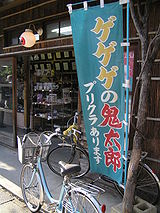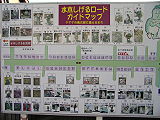- Shigeru Mizuki
-
Mizuki Shigeru
水木 しげるBorn March 8, 1922
Sakaiminato, TottoriNationality Japanese Area(s) Writer, Penciller, Inker, Manga Artist, Notable works GeGeGe no Kitaro
Onwards Towards Our Noble Deaths
Akuma-kun
Kappa no SanpeiShigeru Mizuki (水木 しげる Mizuki Shigeru, born March 8, 1922) is a Japanese manga author, most known for his Japanese horror manga GeGeGe no Kitaro (which was originally titled "Hakaba Kitaro"; see the article in question for details). A specialist in stories of yōkai, he is considered a master of the genre. To a lesser but still notable degree, he is also known for his World War II memoirs, as well as a writer and biographer.
Contents
Life
Born in the coastal town of Sakaiminato, Mizuki was originally named Shigeru Mura (武良 茂 Mura Shigeru), the second of three sons. Described as a drifting, curious child, his earliest pursuits included copious amounts of drawing and hearing ghost stories from a local woman he nicknamed "Nononba".[1]
However, in 1942, he was drafted into the Imperial Japanese Army and sent to New Britain Island in Papua New Guinea. His wartime experiences affected him greatly, as he contracted malaria, watched friends die from battle wounds and disease, and dealt with other horrors of war. Finally, in an Allied air raid, he was caught in an explosion and lost his left arm. While a prisoner of war on Rabaul, he was befriended by the local Tolai tribespeople, who offered him land, a home, and citizenship via marriage to one of the local women. Mizuki acknowledged he considered remaining behind, but was shamed by a military doctor into returning home to Japan first to face his parents, which he did reluctantly.[1]
Upon arriving home, Mizuki had initially planned to return to New Guinea; however, the Occupation of Japan changed that. His injuries did little to help, nor did the fact that his older brother, an artillery officer, was convicted as a war criminal for having prisoners of war executed. From his return until 1956 he worked as a movie theater operator until his break as a cartoonist.
In 1957, Mizuki released his debut work, Rocketman. Since then, he has published numerous works, both on yōkai and military works. He has also written many books on both subjects, including an autobiography about his time on New Britain Island and a manga biography on Adolf Hitler. In 1991, he released a short work titled War and Japan published in The Sixth Grader, a popular edutainment magazine for young people, detailing the atrocities committed by the Japanese Army during their rampage in China and Korea and is narrated by Nezumi Otoko.[2] The work serves as a powerful counterpoint to revisionist manga like the works of Yoshinori Kobayashi and by extension a way for Mizuki to express his anger at those responsible for all of Japan's victims. When not working in either field, he paints a number of subjects, though these works are not as well-known as his literary ones which have made him a household name.
In 2003, he returned to Rabaul to rekindle his friendship with the natives, who had named a road after him in his honor.
In 2005, Shigeru Mizuki appeared in a cameo role in Yōkai Daisenso ("The Great Yokai War") directed by Takashi Miike, a film about yōkai inspired by his work; several of his characters make cameo appearances. A brief explanation about his works also is mentioned in the film.
In 2010 NHK broadcasted an asadora about his married life, Gegege no Nyobo, based on his wife's autobiography.
Sakaiminato
Sakaiminato, the birthplace of Mizuki, has a street dedicated to the ghosts and monsters that appear in his stories. One hundred bronze statues of the story's characters line both sides of the road. There is also a museum.
Awards
Mizuki has won numerous awards and accolades for his works, especially Ge Ge Ge no Kitaro. Among these are:
- 1990 Received Kodansha Manga Award for Komikku Shōwa-Shi.[3]
- 1991 Received Shiju Hōshō Decoration.
- 1995 For the 6th Annual Tokyo Peace Day, he was awarded with an exhibition of his paintings, entitled "Prayer for Peace: Shigeru Mizuki War Experience Painting Exhibition"
- 1996 Received Minister of Education Award.
- 1996 His hometown of Sakaiminato honored him with the Shigeru Mizuki Road, a street decorated with bronze statues of his Ge Ge Ge no Kitaro characters and other designs relating to his works.
- 2003 Received Kyokujitsu Shō Decoration.
- 2003 Sakaiminato honored him again with the Shigeru Mizuki International Cultural Center.
- 2003 Tezuka Osamu Cultural Prize Special Award for his works.
- 2007 Received the Best Album award for NonNonBā at the Angoulême International Comics Festival.
- 2010 Received the Person of Cultural Merit award.[4]
Selected works
Manga
- Hakaba Kitaro (later republished as Ge Ge Ge no Kitaro after the anime)
- Akuma-kun
- Yamato
- Hitler: A Biography
- Kappa no Sanpei
- The Miraculous Notebook (1973) A oneshot published in the magazine Comic Mystery about a notebook that killed whoever's name was written in it. Although rejected, the same idea was used in the smashhit manga Death Note by Tsugumi Ohba and Takeshi Obata. Although this fact was a coincidence, Ohba and Obata went on to refer to the oneshot in the Death Note pilot chapter, which can be found in volume 13.[5]
Books
- Mizuki, Shigeru. "Mizuki Shigeru no Nihon Yōkai Meguri 水木茂るしげるの日本妖怪めぐり trans. Shigeru Mizuki's Ghosts and Demons.
- Rabauru Senki (Memories of Rabaul)
- Mizuki, Shigeru. "Graphic World of Japanese Phantoms". 講談社, 1985. ISBN 978-4-06-202381-8 (4-06-202381-4)
References
- ^ a b http://search.japantimes.co.jp/print/features/life2005/fl20050206x1.htm
- ^ http://www.japanfocus.org/-Matthew-Penney/2905
- ^ Joel Hahn. "Kodansha Manga Awards". Comic Book Awards Almanac. Archived from the original on 2007-08-16. http://web.archive.org/web/20070816031310/http://www.hahnlibrary.net/comics/awards/kodansha.shtml. Retrieved 2007-08-21.
- ^ http://search.japantimes.co.jp/cgi-bin/nn20101027a9.html, Seek Japan, October. 27, 2010.
- ^ http://comipress.com/article/2007/01/08/1287
External links
Categories:- 1922 births
- Japanese writers
- Living people
- Manga artists
- People from Tottori Prefecture
- Winner of Kodansha Manga Award (General)
- Japanese folklorists
- Japanese amputees
- Winner of Tezuka Osamu Cultural Prize (Special Award)
Wikimedia Foundation. 2010.





